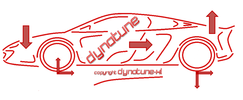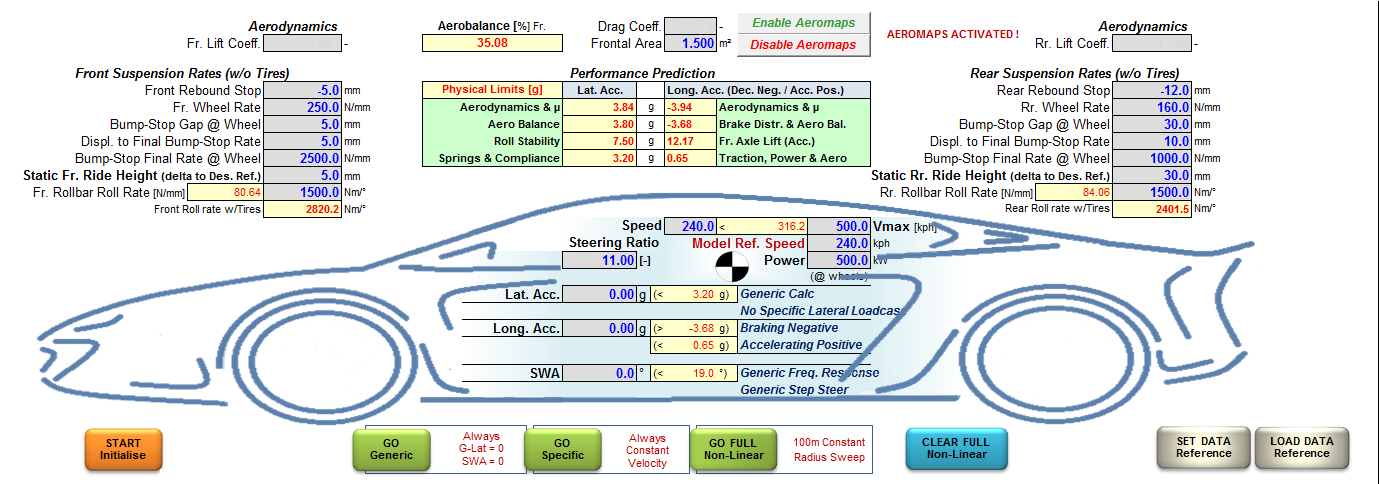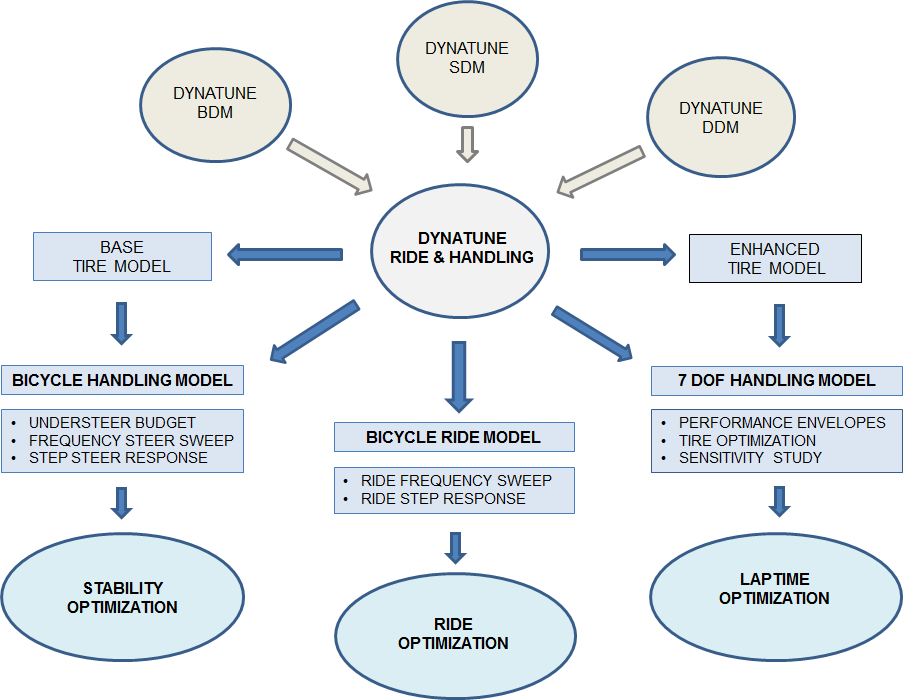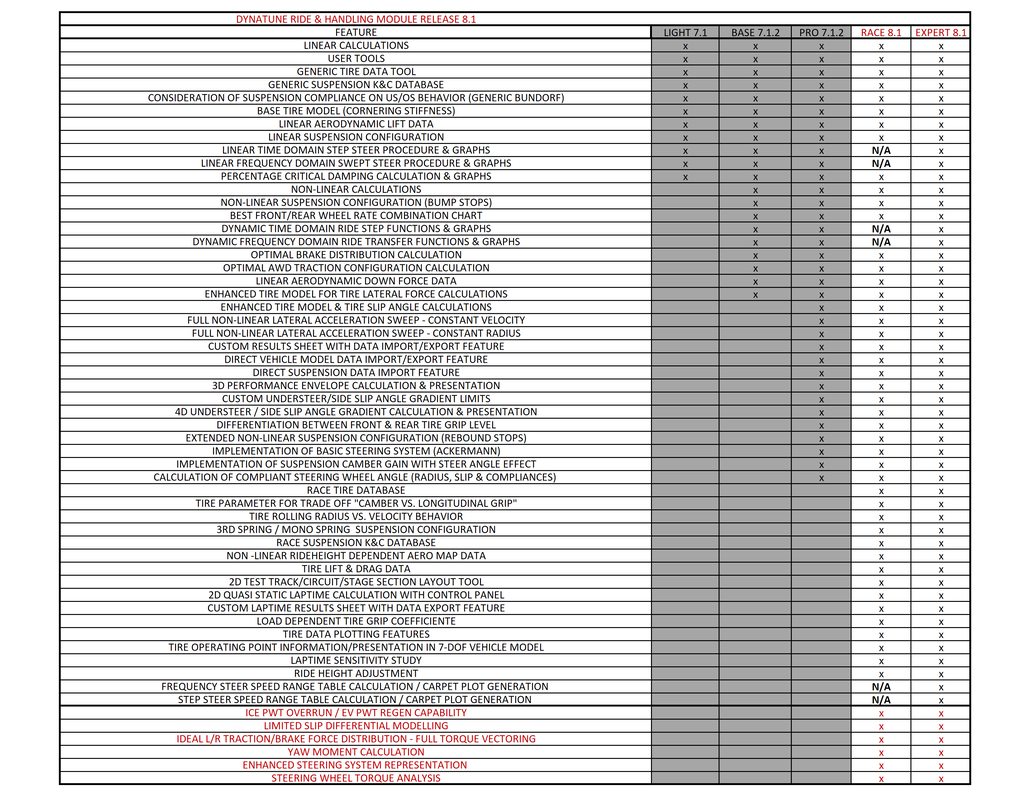DYNATUNE-XL RIDE & HANDLING MODULE (R&H)
|
Leveraging a wealth of knowledge accumulated over years across diverse vehicle types, the DYNATUNE-XL R&H MODULE provides a distinctive simulation platform within MS EXCEL®.
Tailored for professional automotive development engineers, race engineers, mechanical engineering students, and vehicle dynamics enthusiasts, it offers a unique and comprehensive tool for their needs. |
In addition to its established reputation as a valuable development tool, the DYNATUNE-XL R&H MODULE has gained widespread acceptance among concept engineers. Recognized for its role as a swift benchmark and convenient upfront target-setting tool, even lap-time simulation specialists engage in initial setup try-outs within the DYNATUNE-XL R&H MODULE. This allows them to promptly assess the viability of their ideas before committing to a full simulation with complex and cpu-time-consuming models with numerous Degrees of Freedom.
DYNATUNE-XL DOES OFFER TWO DOCUMENTS WHICH ARE INVALUABLE TO USERS WHO ARE SEEKING TO DEEPEN THEIR KNOWLEDGE IN THE FIELD OF VEHICLE DYNAMICS:
- THE 5 "MUST KNOW" FUNDAMENTALS OF VEHICLE DYNAMICS
- THE 10 "EASY" STEPS TO HAPPY VEHICLE DYNAMICS TUNING GUIDE
|
Example Spring, ARB & Damper Setup
|
Example Spring, ARB & Damper Setup
|
Comparison Spring, ARB & Damper Setup
|
The DYNATUNE-XL RIDE & HANDLING MODULE stands as the focal point within the DYNATUNE-XL Simulation Tool Suite. It originated and still serves as an All-In-One Tool for comprehensively analyzing the impact of various parameters on three critical aspects: Vehicle Stability, Maximum Cornering Performance, and Vertical "Ride" Performance. While the RIDE & HANDLING MODULE provides a broad analysis, specific tools within our Suite allow for more in-depth investigations into key parameters within each of these areas.
For a more detailed breakdown of the tools and simulation features related to Vehicle Stability, Maximum Cornering Performance, and Basic Ride Performance, refer to the overview below:
For a more detailed breakdown of the tools and simulation features related to Vehicle Stability, Maximum Cornering Performance, and Basic Ride Performance, refer to the overview below:
2 LEVELS OF CHOICE
Throughout its history, the DYNATUNE-XL R&H has evolved significantly since its initial commercial launch in 2010. It progressed from the "LIGHT" version, advancing through "BASE" and "PRO" versions, ultimately culminating in its two current final versions: RACE and EXPERT, as of RELEASE 8.1.
The table of variants below offers a comprehensive overview of the content available in the RACE and EXPERT versions. It serves as a valuable documentation tool, illustrating the historical evolution of the DYNATUNE-XL R&H MODULE into its diverse and refined variants.
The table of variants below offers a comprehensive overview of the content available in the RACE and EXPERT versions. It serves as a valuable documentation tool, illustrating the historical evolution of the DYNATUNE-XL R&H MODULE into its diverse and refined variants.
|
The Ride & Handling PDF document provides a comprehensive overview of the tool, including all input and output pages, offering as such a full description of the various possibilities of data analysis.
|
The DYNATUNE-XL R&H MODULE is a product crafted and refined in a genuine vehicle dynamics development environment. It is designed to be straightforward, self-explanatory, and dedicated to achieving optimal results with the least amount of necessary data.
|
Setting it apart, the DYNATUNE-XL R&H MODULE eliminates the need for additional complex and costly pre- or post-processing software. Users are not required to be experts in MATLAB®, ADAMS®, or any other pre-/post-processing and analysis tools.
Operating the program requires only basic MS EXCEL® skills and a fundamental understanding of vehicle dynamics. The user-friendly interface is tailored to accommodate users with various skill levels. Each version of the module includes a standard layout of features, tools, and post-processing charts to facilitate efficient analysis. With over twenty years of experience informing its metrics, the DYNATUNE-XL R&H MODULE provides the optimal amount of data required to evaluate the quality of your vehicle. This commitment to simplicity and effectiveness makes it a valuable tool for professionals and enthusiasts alike. |
The historical summary of key features for all available versions up to RELEASE 8.1 are shown In the table above.
Below, you'll find descriptions of all historic versions:
Below, you'll find descriptions of all historic versions:
- Initial Launch (2010) - Introduction of the "LIGHT" version.
- Subsequent Versions - Evolution through "BASE" and "PRO" versions.
- RELEASE 8.1 - Culmination in two final versions, namely "RACE" and "EXPERT."
The DYNATUNE-XL R&H "LIGHT" MODULE stands as the historical foundation of the DYNATUNE-XL Simulation Suite, preserving the original worksheets from 30 years ago. This version focuses on linear calculations, excluding the activation of bump-stops and utilizing the Base Tire Model with a partially linear cornering stiffness approach as the sole tire model. Despite these limitations, approximately 90% of customer-oriented vehicle behavior analysis can be evaluated through linear equations.
Linear models, often referred to as GENERIC in DYNATUNE-XL, serve as the backbone for understanding basic vehicle behavior, similar to linear bicycle models crucial for Electronic Stability Program (ESP) systems. Linear analysis is effective for exploring various aspects, such as aerodynamics, yaw damping, longitudinal load transfer, and weight distribution, influencing tire behavior, vehicle stability, and Under-/Oversteer behavior.
Ride calculations in the "LIGHT" version concentrate on Natural Frequencies, Bounce & Pitch Centers, and the calculation of Percentage Critical Damping. Tire grip level and aerodynamic data are limited to typical road car values.
Each DYNATUNE-XL MODULE includes a "USER" sheet, allowing users to perform additional custom calculations. The "LIGHT" version is designed primarily for novices, students, and enthusiasts interested in Vehicle Dynamics. While lacking non-linear effects, it serves as an optimal tool for grasping the basics of vehicle behavior without the complexity introduced by various non-linear components. This makes it an essential tool for automotive engineers working in the field of vehicle dynamics.
Linear models, often referred to as GENERIC in DYNATUNE-XL, serve as the backbone for understanding basic vehicle behavior, similar to linear bicycle models crucial for Electronic Stability Program (ESP) systems. Linear analysis is effective for exploring various aspects, such as aerodynamics, yaw damping, longitudinal load transfer, and weight distribution, influencing tire behavior, vehicle stability, and Under-/Oversteer behavior.
Ride calculations in the "LIGHT" version concentrate on Natural Frequencies, Bounce & Pitch Centers, and the calculation of Percentage Critical Damping. Tire grip level and aerodynamic data are limited to typical road car values.
Each DYNATUNE-XL MODULE includes a "USER" sheet, allowing users to perform additional custom calculations. The "LIGHT" version is designed primarily for novices, students, and enthusiasts interested in Vehicle Dynamics. While lacking non-linear effects, it serves as an optimal tool for grasping the basics of vehicle behavior without the complexity introduced by various non-linear components. This makes it an essential tool for automotive engineers working in the field of vehicle dynamics.
The DYNATUNE-XL R&H "BASE" MODULE builds upon the "LIGHT" Version, introducing a key feature — the ability to incorporate a non-linear bump-stop. This addition significantly influences RIDE & HANDLING characteristics, though it introduces increased complexity due to the non-linear behavior. The base non-linear calculation allows the investigation of specific points of interest for given parameters like Speed, Steering Wheel Angle, or a combination of Lateral and Longitudinal Acceleration. These points can be compared to results from the GENERIC linear calculation.
Ride calculations in the "BASE" Version offer additional features compared to the "LIGHT" Version, including Carpet Plots for selecting optimal front and rear wheel rate combinations. Additionally, there's the capability to calculate a linear Ride Step Input Response, a dynamic event in the time domain simulating a discrete obstacle, providing a more in-depth evaluation of transient damping effects on body and wheel movements. Another feature is the Ride Frequency Transfer Function, allowing frequency domain analysis and plotting frequency-related damping behavior of the front and rear body & wheels.
Tire grip levels now include slick tire friction coefficient levels, and aerodynamic data can reflect the effects of Non-Ride-Height dependent aerodynamic downforce coefficients.
The "BASE" Version equips users with the fundamental principles for non-linear analysis. It's suitable for those with a basic understanding of Vehicle Dynamics who seek to enhance their skills and delve into the intricate world of non-linear back-coupling involving aerodynamics, bump stops, riding heights, etc.
Starting from "BASE" Versions in the DYNATUNE-XL R&H MODULES for RELEASE 7.0 and above, various new USER-TOOLS have been introduced. Notable tools include the SUSPENSION DATA TOOL and TIRE DATA TOOL, providing foundational knowledge for Tire Data and Suspension Kinematic & Compliance Data. These tools suggest commonly used data based on a range of parameters for the selected Tire or Suspension. Users can plot their own tire data and automatically copy selected data to the corresponding input cells on the data sheets.
To enhance the accuracy of high lateral acceleration NON-LINEAR Calculations in the "BASE" Version and above, an "Enhanced Tire Model" is optionally available. It generates a full NON-LINEAR tire look-up table MAP for Slip Angle vs. Lateral Force vs. Vertical Force based on the partially linear "Basic Tire Model."
Ride calculations in the "BASE" Version offer additional features compared to the "LIGHT" Version, including Carpet Plots for selecting optimal front and rear wheel rate combinations. Additionally, there's the capability to calculate a linear Ride Step Input Response, a dynamic event in the time domain simulating a discrete obstacle, providing a more in-depth evaluation of transient damping effects on body and wheel movements. Another feature is the Ride Frequency Transfer Function, allowing frequency domain analysis and plotting frequency-related damping behavior of the front and rear body & wheels.
Tire grip levels now include slick tire friction coefficient levels, and aerodynamic data can reflect the effects of Non-Ride-Height dependent aerodynamic downforce coefficients.
The "BASE" Version equips users with the fundamental principles for non-linear analysis. It's suitable for those with a basic understanding of Vehicle Dynamics who seek to enhance their skills and delve into the intricate world of non-linear back-coupling involving aerodynamics, bump stops, riding heights, etc.
Starting from "BASE" Versions in the DYNATUNE-XL R&H MODULES for RELEASE 7.0 and above, various new USER-TOOLS have been introduced. Notable tools include the SUSPENSION DATA TOOL and TIRE DATA TOOL, providing foundational knowledge for Tire Data and Suspension Kinematic & Compliance Data. These tools suggest commonly used data based on a range of parameters for the selected Tire or Suspension. Users can plot their own tire data and automatically copy selected data to the corresponding input cells on the data sheets.
To enhance the accuracy of high lateral acceleration NON-LINEAR Calculations in the "BASE" Version and above, an "Enhanced Tire Model" is optionally available. It generates a full NON-LINEAR tire look-up table MAP for Slip Angle vs. Lateral Force vs. Vertical Force based on the partially linear "Basic Tire Model."
The DYNATUNE-XL R&H "PRO" MODULE does offer a remarkable user convenience feature, allowing users to save the currently used car data set as a Reference Data Set or reload the Reference Data Set in a dedicated RESULTS sheet. This feature facilitates quick comparisons between two or more variants, streamlining the analysis process. The RESULTS sheet not only summarizes all input and output data for the current and reference models but also provides room for additional data and custom post-processing.
In 7.0's "PRO" Version, a notable addition is the calculation procedures for PERFORMANCE ENVELOPES. These envelopes cover all combinations of lateral and longitudinal accelerations as a function of velocity and are visually represented as 3-dimensional Carpet Plots. Additionally, Understeer & Sideslip Angle Gradients are depicted in an isometric 3.5D projection, offering a unique and comprehensive understanding of vehicle behavior in multiple dimensions. These calculations can be executed in both LINEAR and NON-LINEAR modes.
The DYNATUNE-XL R&H "PRO" MODULE is tailored for professionals and enthusiasts who aim to delve deeply into understanding and learning about Vehicle Dynamics using OEM Standards and Test-Procedures, making it a powerful tool for in-depth analysis and insights.
In 7.0's "PRO" Version, a notable addition is the calculation procedures for PERFORMANCE ENVELOPES. These envelopes cover all combinations of lateral and longitudinal accelerations as a function of velocity and are visually represented as 3-dimensional Carpet Plots. Additionally, Understeer & Sideslip Angle Gradients are depicted in an isometric 3.5D projection, offering a unique and comprehensive understanding of vehicle behavior in multiple dimensions. These calculations can be executed in both LINEAR and NON-LINEAR modes.
The DYNATUNE-XL R&H "PRO" MODULE is tailored for professionals and enthusiasts who aim to delve deeply into understanding and learning about Vehicle Dynamics using OEM Standards and Test-Procedures, making it a powerful tool for in-depth analysis and insights.
The DYNATUNE-XL R&H "RACE" MODULE surpasses the "LIGHT," "BASE," and "PRO" versions by incorporating additional features specifically tailored for the demands of a racing environment. These include:
Please note that in the "RACE" Version, generic STEP STEER & FREQUENCY STEER, as well as generic RIDE STEP & RIDE FREQUENCY calculation procedures, have been eliminated to optimize CPU time. The software is specifically designed for a racing environment with a primary focus on vehicle setups optimized for achieving maximum lateral acceleration.
Additionally, the "RACE" Version comes with a typical Wing Car Data set, encompassing Aero, Tires, and Compliance parameters.
- Speed Dependent Tire Rolling Radius: Accounting for changes in tire rolling radius with speed, a critical factor in racing scenarios.
- Full Ride-Height Dependent 3D Aerodynamic Maps: Particularly useful for wing cars, providing a comprehensive representation of aerodynamic characteristics as a function of ride height.
- Special Suspension Adaptions for 3rd Spring F1 Suspension Layouts: Customized adaptations to accommodate the unique features of third spring layouts in Formula 1 suspensions.
Please note that in the "RACE" Version, generic STEP STEER & FREQUENCY STEER, as well as generic RIDE STEP & RIDE FREQUENCY calculation procedures, have been eliminated to optimize CPU time. The software is specifically designed for a racing environment with a primary focus on vehicle setups optimized for achieving maximum lateral acceleration.
Additionally, the "RACE" Version comes with a typical Wing Car Data set, encompassing Aero, Tires, and Compliance parameters.
The DYNATUNE-XL R&H "EXPERT" MODULE seamlessly integrates all the features from both the "PRO" and "RACE" Versions into a unified tool. It is designed for individuals who wish to comprehensively investigate all aspects of Vehicle Dynamics without resorting to highly complex (multi-body systems) tools. Unlike such tools that require significant training time, involve considerable license costs, and often demand expensive hardware for optimal performance, the "EXPERT" Version provides a robust and efficient solution. It is an ideal choice for those seeking an all-encompassing tool that balances advanced features with user-friendly accessibility.
























